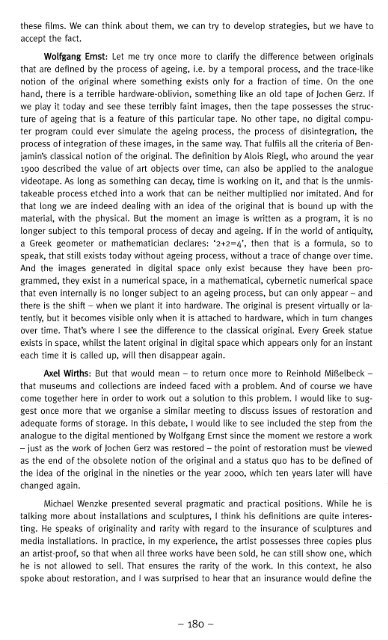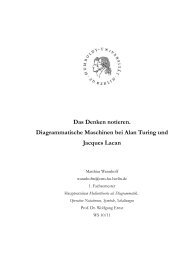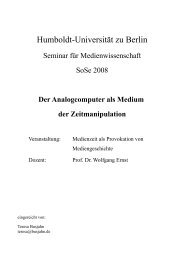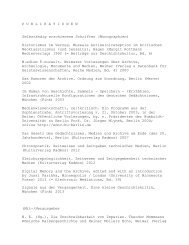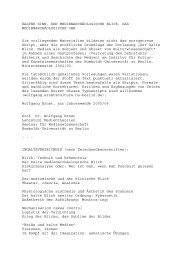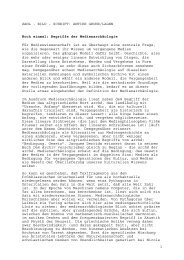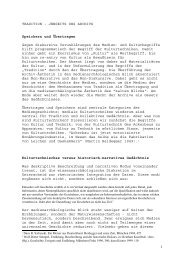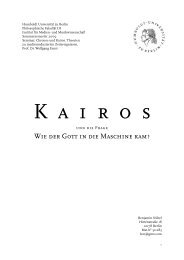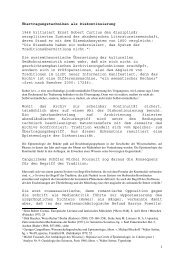Download - Medienwissenschaft
Download - Medienwissenschaft
Download - Medienwissenschaft
You also want an ePaper? Increase the reach of your titles
YUMPU automatically turns print PDFs into web optimized ePapers that Google loves.
these films. We can think about them, we can try to develop strategies, but we have to<br />
accept the fact.<br />
Wolfgang Ernst: Let me try once more to clarify the difference between originals<br />
that are defined by the process of ageing, i.e. by a temporal process, and the trace-like<br />
notion of the original where something exists only for a fraction of time. On the one<br />
hand, there is a terrible hardware-oblivion, something like an old tape of Jochen Gerz. If<br />
we play it today and see these terribly faint images, then the tape possesses the structure<br />
of ageing that is a feature of this particular tape. No other tape, no digital computer<br />
program could ever simulate the ageing process, the process of disintegration, the<br />
process of integration of these images, in the same way. That fulfils all the criteria of Benjamin's<br />
classical notion of the original. The definition by Alois Riegl, who around the year<br />
1900 described the value of art objects over time, can also be applied to the analogue<br />
videotape. As long as something can decay, time is working on it, and that is the unmistakeable<br />
process etched into a work that can be neither multiplied nor imitated. And for<br />
that long we are indeed dealing with an idea of the original that is bound up with the<br />
material, with the physical. But the moment an image is written as a program, it is no<br />
longer subject to this temporal process of decay and ageing. If in the world of antiquity,<br />
a Greek geometer or mathematician declares: '2+2=4', then that is a formula, so to<br />
speak, that still exists today without ageing process, without a trace of change over time.<br />
And the images generated in digital space only exist because they have been programmed,<br />
they exist in a numerical space, in a mathematical, cybernetic numerical space<br />
that even internally is no longer subject to an ageing process, but can only appear- and<br />
there is the shift - when we plant it into hardware. The original is present virtually or latently,<br />
but it becomes visible only when it is attached to hardware, which in turn changes<br />
over time. That's where I see the difference to the classical original. Every Greek statue<br />
exists in space, whilst the latent original in digital space which appears only for an instant<br />
each time it is called up, will then disappear again.<br />
Axel Wirths: But that would mean - to return once more to Reinhold Mißelbeck -<br />
that museums and collections are indeed faced with a problem. And of course we have<br />
come together here in order to work out a solution to this problem. I would like to suggest<br />
once more that we organise a similar meeting to discuss issues of restoration and<br />
adequate forms of storage. In this debate, I would like to see included the step from the<br />
analogue to the digital mentioned by Wolfgang Ernst since the moment we restore a work<br />
- just as the work of Jochen Gerz was restored - the point of restoration must be viewed<br />
as the end of the obsolete notion of the original and a status quo has to be defined of<br />
the idea of the original in the nineties or the year 2000, which ten years later will have<br />
changed again.<br />
Michael Wenzke presented several pragmatic and practical positions. While he is<br />
talking more about installations and sculptures, I think his definitions are quite interesting.<br />
He speaks of originality and rarity with regard to the insurance of sculptures and<br />
media installations. In practice, in my experience, the artist possesses three copies plus<br />
an artist-proof, so that when all three works have been sold, he can still show one, which<br />
he is not allowed to sell. That ensures the rarity of the work. In this context, he also<br />
spoke about restoration, and I was surprised to hear that an insurance would define the<br />
- 180-


